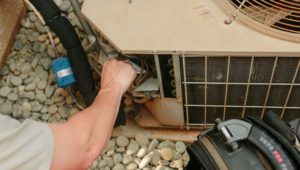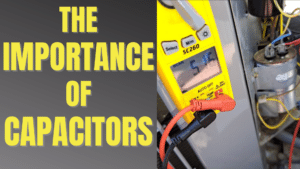Today I want to expand on our recent gas furnace troubleshooting series. “The Easy Guide to Diagnosing a Bad Furnace Inducer Motor” will fill you in on what the inducer motor does, why it’s important, the most common of ways I’ve found inducer motors fail, and how to let the customer know what you’ve found. That’s coming up here on Fox Family Heating & Air.
First, I want to give fair warning to anyone watching this that is not already an experienced technician in the HVAC industry. This video is for educational purposes only. Fox Family Heating and Air does not recommend anyone other than a professional to start opening the furnace up and trying to diagnose the failure going on with your system.
There are high and low voltages that can shock a person. There are also lots of moving parts that can damage body parts—namely, hands and fingers. The furnace also produces hot surfaces within the furnace compartments and around the housing, which can cause severe burns. An actual flame produced by the ignition and startup of a gas furnace can cause severe burns and damage to a person or property.
First, as a technician, you must know the sequence of events that occurs for a gas furnace to start up properly. It’s straightforward, and you should have this memorized before you can even consider being qualified to troubleshoot.
- Power to the furnace control board
- Thermostat signals the call for heat
- Inducer motor kicks on
- Pressure switch proves the inducer operates correctly
- Ignitor activates
- Gas valve energizes
- Flame pours across burners
- Flame sensor proves all burners are lit
- Blower forces air through the ducts
When a furnace begins a new cycle, the inducer motor is the first thing you should see kick on. 120 volts are applied through the wires coming from the control board. This starts the furnace inducer motor for up to 60 seconds before anything else even happens. It’s a safety feature that creates a negative pressure or draft that purges the heat exchanger of any poisonous gasses, namely the combustion’s biproducts. It makes the air inside the heat hollow tubes of the heat exchanger cleaner when the flame kicks on. With cleaner air inside the heat exchanger at the time of combustion, the furnace’s efficiency increases.
Without going into it too much, a safety device called a pressure switch activates when the diaphragm inside of it recognizes the suction or purging action of the furnace inducer motor. There’s another video called The Easy Guide to Diagnosing a Bad Pressure Switch, and I’ll make sure it’s attached to the end screen so you can check that out. But first, you want to know more about the inducer more and how to troubleshoot it.
If the inducer motor doesn’t turn on when it’s supposed to, the furnace will recognize this and shut down. It will wait a bit and try again. If the motor doesn’t start after 3 to 5 tries, the control board will stop sending voltage to the inducer motor, and essentially locking it out from attempting it anymore.
Why Furnace Inducer Motors Fail
If the correct voltage is applied to the inducer motor and it’s not turning on, something’s not right. Let’s dig into why:
Unplug the furnace, which removes power to the system.
Is the base of the motor warm or hot to the touch? This means it’s been trying to spin, but something is holding it up. Is the flywheel on the motor or the actual squirrel cage unable to spin when you manually try to turn it? This can be a reliable indicator that the motor is bad and needs to be replaced.
Why is this happening?
One reason the motor’s shaft locks up is that the motor’s bearings may be seized, preventing it from turning. Another reason has to do with the windings inside the motor. One of them could be open—usually, the start winding in this case. And finally, some motors have a capacitor that starts the motor and regulates the voltage while it’s running. If it is a bad capacitor, a new one should get it going again.
One of the first indicators that a furnace inducer motor is on borrowed time is if it’s making odd noises. Sometimes it’s a rattling noise, a clanking noise, chattering, pinging, shaking, a wobbling noise – you name it! If it comes on and runs any other way than what you interpret as normal, based on your training and experience with properly operating furnaces, you can see if it’s something you can physically adjust. If not, the inducer motor should be considered bad. Why? Because it’s not running to manufacturers specs.
Think Like the Furnace Builder
Think about it like this. Would the furnace’s builder, who takes a ton of pride in their system’s operation, send this out into the field to be installed, knowing the inducer motor is making a god-awful noise? The answer is a resounding no! And you should know that and be comfortable telling the customer this.
Because many inducer motors are nearly impossible to rebuild, an entirely new unit must be purchased in most cases when one wears out. One of the exceptions to this is the occasional Carrier or Bryant units.
Ordering the Furnace Inducer Motor
So at this point, this is what I need my technicians to do. Inducer motors are ordered through the manufacturer. And since we have flat-rate pricing, which includes the cost of parts, labor, and warranty, if the motor is less than $100, it is a level 7. Above $100 is a level 8. $200 and above, they need to call a supervisor for pricing.
Be Prepared with Information
You want to know the pricing and availability before you talk to the customer because you want to minimize the number of times you need to bring the customer information. Coming to them and telling them the inducer motor is bad just to hear them say, “Okay, how much is it?” then means you must find out, come back, and tell them it’s the such-and-such price. You get their approval on the price, but they want to know when the repair will occur. You’ll need to call back to your parts warehouse to ask when the part will be available. You then must go back to tell them the part will be in around 5 to 7 business days from the factory.
All of this back and forth can be avoided if you have all the necessary information upfront before even telling them about the diagnosis. Even if they don’t go with your repair, you have the information and can log it in your file for the customer if they call back, approving the repair a month from now.
Communicating with the Customer
Once we determine pricing and availability, it’s time to talk to the customer about our diagnosis. We explain what we found, let the customer know the price, and let them know when we can come back to repair the system.
Just a word to the wise: good communication between you and the customer would mean telling them they need to change this part on the furnace before seeing if anything else is wrong with the system. Sometimes you’ll get a customer that asks, “So this will fix my system and get it going again, right?” Well, you don’t really know because you haven’t seen what the rest of the startup sequence and the cycling off of the system is doing, have you?
It’s very likely the rest of the system will work since multiple failures are pretty rare, but you’re going to feel like a jerk if you forget to tell them you have to see how the rest of the system operates after you replace the inducer motor. Coming back to them after you’ve replaced the motor only to say, “Oh yeah, now your gas valve isn’t working, that’ll be another $600.” So just remember, without a properly functioning inducer motor, there’s no way to tell if the rest of the system is working to manufacturer specs.
If it is a part that’s available for pickup, call the office to determine a date to pick it up and return and complete the replacement. If it is a part that needs to be shipped, we want to let the customer know that the part should be arriving at said date and that we’ll call to schedule the appointment when the part arrives. You’d also want to communicate to the customer and the office how long the repair will take.
During the inducer motor installation, we need to either replace the gasket (usually comes with the new motor) or make a gasket with high temp silicone. Once installed, a good technician will test the system for proper operation to ensure there are no other issues with the furnace.
Diagnosing a Furnace Inducer Motor: A Recap
So, just to recap, inducer motors pull the flame through the heat exchanger and vent the exhaust through the roof. To determine an inducer motor’s failure, we need to verify the proper voltage is being sent to it. If the motor has proper voltage, the capacitor tests good and is not turning on, the motor is bad. If it’s making a lot of noise, the homeowner should know the part is working but is on borrowed time.
Thanks so much for stopping by, and we’ll see you on the next blog post.
Don’t miss our video series on this topic:




















